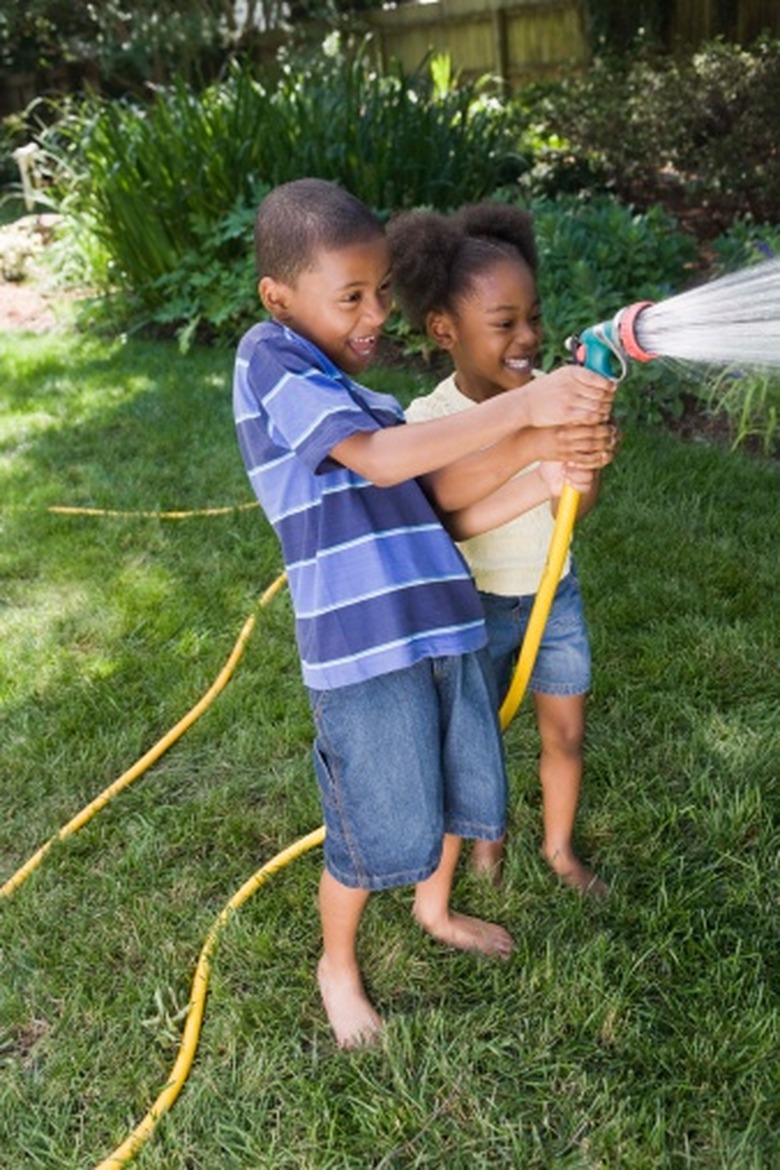How To Install Outdoor Faucets In Mobile Homes
Things Needed
-
Male threaded PVC coupling
-
Teflon tape
-
Rags
-
Channel lock pliers
-
Outdoor faucet
-
Drill with 1/4-inch bit, 1/2-inch bit and 1-inch hole saw
-
Pencil
-
Caulk gun with 30 year silicone
-
1/4-inch bolts with washers and nuts
-
Adjustable wrench
-
3/4-inch PVC pipe
-
Hacksaw
-
Sandpaper
-
PVC primer
-
PVC glue
-
PVC couplings (straight as well as 90 and 45 degree angles)
-
PVC "T" coupling
-
Tie wire
-
Lineman's pliers
-
Work gloves
-
Safety glasses
-
Dust mask
Warning
Work gloves and safety glasses are required when using hand tools. A dust mask is required when working with chemicals. Remove all the underpinning before using chemicals under a mobile home. Have an assistant nearby when working in enclosed spaces with chemicals to monitor you for signs of trouble. Take frequent breaks to allow the fumes to dispel and keep your head clear.
The plumbing and other utilities in your mobile home are installed at the factory along with everything else, but outdoor faucets are not a normal fixture. However, since the utilities of your trailer are easily accessible under the main structure, it is possible to cut into the existing water line and add an outdoor faucet. This new fixture will provide you with an outdoor water source for all your gardening, lawn care and other household needs.
Step 1
Turn off the water supply to the mobile home. Find the spot under the trailer where the water line runs in and connects to the plumbing. Turn on all the faucets inside the mobile home and let the lines drain.
Step 2
Wrap Teflon tape around the threads of the male threaded PVC coupling. Twist the coupling into the back of the outdoor faucet. Wrap the PVC with a rag, grab it with your channel lock pliers and snug the connection. Be careful not to tighten the fitting too much.
Step 3
Drill into the side of the mobile home with a quarter-inch bit. Make your hole 3 inches above the skirting so it exposes the underside of the trailer instead of breaching the interior wall. Widen the hole with a half-inch bit, then again with a 1-inch hole saw.
Step 4
Slide the PVC coupling attached to the faucet through the hole in the side of the mobile home. Turn the faucet upright. Mark the retaining holes in the faucet body on the siding with your pencil. Remove the faucet assembly and drill through the marks with a quarter-inch bit. Use your caulk gun to apply a thick bead of silicone around all three holes.
Step 5
Slip the PVC coupling on the faucet through the large hole and realign the faucet so the retaining holes match. Slide a bolt through each retaining hole. Have an assistant hold the assembly in place. Climb under the trailer and slip a washer onto each of the bolts. Twist a nut onto each one and snug the assembly with your adjustable wrench. Wipe away the excess silicone on the wall with a wet rag.
Step 6
Locate the nearest water line under the mobile home. Hold your "T" coupling up to the water line. Mark the waterline at each end of the "T" coupling. Remove the coupling. Make a second set of marks a half-inch inside of each of the first two marks. Cut through the water line at each of the inside marks. Discard the piece that was between them. Sand the ends of the exposed pipe.
Step 7
Apply PVC primer to the outside of both ends of the water line you just cut and to the inside of each of the openings on the "T" coupling. Apply PVC glue to the ends of the pipes. Slide one pipe into each of the holes on the longest arm on the "T" with the free opening facing your faucet.
Step 8
Prime and glue one end of a pipe. Slip it into the open end of the "T". Build your pipe towards the faucet. Cut the pipe as necessary. Use straight couplings as well as 90-degree and 45-degree angle couplings to reach your destination.
Step 9
Glue the final piece together. Cut pieces of tie wire with your lineman's pliers to secure the pipes to the metal trusses under the mobile home. Let the glue dry four hours. Turn on the main water supply to the trailer. Look for leaks. Turn off the faucets inside the mobile home once the water runs smoothly and there is no more air in the lines.
